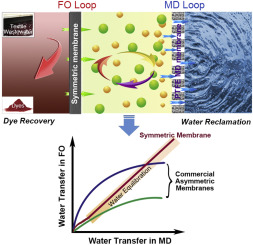Water Research ( IF 11.4 ) Pub Date : 2020-01-09 , DOI: 10.1016/j.watres.2020.115488 Meng Li , Kun Li , Lianjun Wang , Xuan Zhang

|
The forward osmosis-membrane distillation (FO-MD) hybrid process has shown great promise in achieving zero liquid discharge in the textile industry, recovering valuable dye molecules while producing large amounts of clean water. However, the progress of this technology seems to have stagnated with the direct coupling of commercial asymmetric FO and MD membranes, because water management in the system is found to be rather complicated owing to the processing of the different membranes. Herein, we propose, for the first time, an FO-MD hybrid process using a custom-made self-standing and symmetric membrane and a hydrophobic polytetrafluoroethylene membrane in the FO and MD units, respectively. Three types of operation modes were investigated to systematically study the process performance in the concentration treatment of model textile wastewater; two commercial FO membranes were also tested for comparison. Owing to its low fouling propensity and lack of an internal concentration polarization effect, the water transfer rate of our symmetric FO membrane quickly reaches equilibrium with that in the MD unit, resulting in continuous and stable operation. Consequently, the hybrid process using the symmetric FO membrane was found to consume the least energy, as indicated by its lowest total cost in both lab- and large-scale systems. Overall, our study provides a new strategy for using a symmetric FO membrane in the FO-MD hybrid process and highlights its great potential for use in the treatment of textile wastewater.
中文翻译:

使用混合正渗透-膜蒸馏(FO-MD)工艺浓缩纺织废水的可行性:性能和经济评估
正渗透膜蒸馏(FO-MD)混合工艺在纺织业实现零液体排放,回收有价值的染料分子并产生大量纯净水的过程中显示出巨大的希望。然而,由于不对称的FO和MD膜的直接耦合,该技术的进展似乎停滞了,因为由于处理不同的膜,发现系统中的水管理相当复杂。在此,我们首次提出在FO和MD单元中分别使用定制的自立和对称膜和疏水性聚四氟乙烯膜的FO-MD混合工艺。研究了三种操作模式,以系统地研究模型纺织品废水浓缩处理的过程性能。还测试了两种市售FO膜进行比较。由于其低结垢倾向和内部浓度极化效应的缺乏,我们的对称FO膜的水传输速率与MD单元中的水传输速率迅速达到平衡,从而可连续且稳定地运行。因此,发现使用对称FO膜的混合工艺消耗的能量最少,这在实验室和大型系统中总成本最低。总体而言,我们的研究提供了在FO-MD混合工艺中使用对称FO膜的新策略,并强调了其在处理纺织废水中的巨大潜力。我们的对称FO膜的水传输速率迅速与MD单元达到平衡,从而实现连续稳定的运行。因此,发现使用对称FO膜的混合工艺消耗的能量最少,这在实验室和大型系统中总成本最低。总体而言,我们的研究提供了在FO-MD混合工艺中使用对称FO膜的新策略,并强调了其在处理纺织废水中的巨大潜力。我们的对称FO膜的水传输速率迅速与MD单元达到平衡,从而实现连续稳定的运行。因此,发现使用对称FO膜的混合工艺消耗的能量最少,这在实验室和大型系统中总成本最低。总体而言,我们的研究提供了在FO-MD混合工艺中使用对称FO膜的新策略,并强调了其在处理纺织废水中的巨大潜力。











































 京公网安备 11010802027423号
京公网安备 11010802027423号